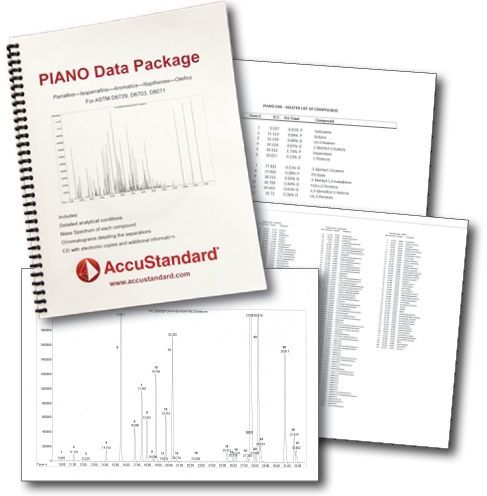Click "Allow Cookies" to consent to storing cookies on your device to improve your experience on our site. Learn more.
PIANO (Paraffins, Isoparaffins, Aromatics, Naphthenes, Olefins)

ASTM D6729, D6730, D8071
AccuStandard offers a petroleum naphtha-based PIANO mix (acronym for Paraffins, Isoparaffins, Aromatics, Naphthenes and Olefins). This mix is used to identify hydrocarbon components in spark-ignition engine fuels, including oxygenated blends of ethanol and tert-butyl methyl ether, with boiling ranges to 225°C in accordance with ASTM Methods D6729-04, D6730-01, and D8071-17.
The data package provides the elution order and identities of the PIANO mix components. This information will be accurate and consistent for any gas chromatographic separation employing a methyl siloxane phase capillary column.
Two hundred fourteen (214) individual hydrocarbons have been identified with a total of 263 compounds separated into the appropriate chemical class within the PIANO designation. These compounds comprise the master list. Each entry contains the Total Ion Chromatogram peak number, retention time, percent of the total and compound name.
To simplify component identification, all compounds have been grouped into chemical classes with the paraffin and isoparaffin classes combined to optimize the format. Each entry contains the same information as the master list. The identified components in each chemical class include:
- • 79 paraffins/isoparaffins
- • 63 aromatics
- • 73 naphthenes
- • 48 olefins
The master list is further categorized via extracted ion plots utilizing key ions for each chemical class. The retention time of each component in the extracted ion plot can be compared to the master list for identification.
The analysis of the mix was performed on a 100 meter methyl siloxane phase capillary column with a 1.0 μm film (Quadrex Corporation, Bethany, CT.) in an attempt to improve low boiling range component separation.
As in other published analyses, the complexity of the petroleum product resulted in a number of co-elutions and chromatographic peaks that cannot be identified with an acceptable degree of certainty. Consequently, the analysis and data are subject to the same disclaimers enumerated in ASTM Method D 6729-04 regarding the estimation of bulk hydrocarbon group-type composition. The chromatograms provided have been integrated to optimize the usefulness of the analysis and reduce the number of unidentified components present on the chromatogram.
The identification of each hydrocarbon was based on the following:
Data package includes:
- Detailed analytical conditions
- Mass Spectrum of each compound
- Chromatograms detailing separations
PIANO Gasoline
PIANO Gasoline (contains Ethanol)
PIANO Gasoline (contains MtBE)
PIANO Mix Documentation Sample

